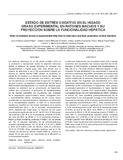| dc.rights.license | http://creativecommons.org/licenses/by-nc-sa/3.0/ve/ | |
| dc.contributor.author | López Ortega, Aura | |
| dc.contributor.author | Márquez Alvarado, Ysabel | |
| dc.contributor.author | Aranguren Parra, Aleidy Josefina | |
| dc.contributor.author | Plaza Carrión, Miguel Ángel | |
| dc.contributor.author | Murillo López de Silanes, María Divina | |
| dc.date.accessioned | 2017-10-19T16:58:00Z | |
| dc.date.available | 2017-10-19T16:58:00Z | |
| dc.date.issued | 2017-07 | |
| dc.identifier.issn | 0798-2259 | |
| dc.identifier.uri | http://www.saber.ula.ve/handle/123456789/43869 | |
| dc.description.abstract | En medicina veterinaria, el rol del estrés oxidativo (EO) en la producción y reproducción animal ha adquirido relevancia debido al deterioro de ambas funciones en animales con hepatoesteatosis o hígado graso (HG). Este estudio tuvo el objetivo de determinar si en el HG experimental causado por etionina en ratones machos NMRI adultos, se establecía un estado de EO hepático y se alteraba la función del hígado. Se utilizaron dos grupos de 10 animales: uno control y otro tratado con DL-etionina por vía intraperitoneal en dosis de 7,5 mg/20 g de peso corporal. La magnitud y características del HG fueron determinadas histológicamente y la cuantía del depósito graso hepático se estableció por la concentración de triglicéridos, análisis que corroboraron la generación de hepatoesteatosis en los machos inyectados con DL-etionina. Los productos de la degradación lipoperoxidativa, dienos conjugados (DC) y malondialdehído (MDA), indicadores de EO celular, fueron cuantificados por espectrofotometría, mediante su concentración en el homogeneizado hepático. El daño en la funcionalidad hepática se cuantificó por los niveles plasmáticos de la alanina aminotransferasa (ALT) y de la aspartato aminotransferasa (AST), mediante kits comerciales. La inducción de HG causó una elevación significativa de los DC: de 231,18 ± 15,53 µmoles/mg proteínas a 297,45 ± 23,10 mmoles/mg proteínas (P<0,05), así como del MDA: de 364,91 ± 17,73 nmoles/mg proteínas a 852,91 ± 55,26 nmoles/mg proteínas (P<0,001). En los ratones con HG, la actividad plasmática de las aminotransferasas aumentó significativamente: ALT de 59,40 ± 5,16 U/l a 169,86 ± 18,78 U/l (P<0,001) y AST de 158,35 ± 13,54 U/l a 241,93 ± 10,14 U/l (P<0,05). Estos resultados muestran que en el HG inducido por etionina en ratones machos NMRI se produce un estado de EO que podría ser responsable de la alteración en la funcionalidad hepática. | es_VE |
| dc.language.iso | es | es_VE |
| dc.publisher | SABER-ULA | es_VE |
| dc.rights | info:eu-repo/semantics/openAccess | |
| dc.subject | Hígado graso | es_VE |
| dc.subject | Etionina | es_VE |
| dc.subject | Estrés oxidativo | es_VE |
| dc.subject | Disfunción | es_VE |
| dc.title | Estado de estrés oxidativo en el hígado graso experimental en ratones machos y su proyección sobre la funcionalidad hepática | es_VE |
| dc.title.alternative | State of oxidative stress in experimental fatty liver in male mice and their projection on liver function | es_VE |
| dc.type | info:eu-repo/semantics/article | |
| dc.description.abstract1 | In veterinary medicine the role of oxidative stress (OS) in animal production and reproduction has become important due to the alteration of both functions in animals with hepatosteatosis or fatty liver (FL). This study aimed to determine whether a state of hepatic OS was established in the experimental FL caused by ethionine in adult male mice NMRI, and whether liver function was altered. Two groups of 10 animals were used: one control and another treated with DL-ethionine intraperitoneally at 7.5 mg/20 g body weight. The magnitude and characteristics of FL were determined histologically and the amount of liver fat depot was established by the concentration of triglycerides. Both analysis corroborated generation of hepatosteatosis in males injected with DL-ethionine. Products from lipoperoxidative degradation (conjugated dienes (CD) and malondialdehyde (MDA), indicators of cellular OS, were quantified spectrophotometrically by its concentration in liver homogenate. Damage to liver function was measured by plasmatic levels of alanine aminotransferase (ALT) and aspartate aminotransferase (AST), using commercial kits. The induction of FL caused a significant rise in CD from 231.18 ± 15.53 µmoles/mg protein to 297.45 ± 23.10 mmoles/mg protein (P<0.05), as well as the MDA: from 364.91 ± 17.73 nmoles/mg protein to 852.91 ± 55.26 nmoles/mg protein (P<0.001). In mice with FL aminotransferases plasmatic activity increased significantly: ALT of 59.40 ± 5.16 U/l from 169.86 ± 18.78 U/l (P<0.001) and AST from 158.35 ± 13.54 U/l to 241.93 ± 10.14 U/l (P<0.05). These results show that in ethionine-induced FL in male NMRI mice a state of OS is induced that could be responsible for the alteration in liver function. | es_VE |
| dc.description.colacion | 220-226 | es_VE |
| dc.description.email | alopez@ucla.edu.ve | es_VE |
| dc.description.email | isabelmarquez@ucla.edu.ve | es_VE |
| dc.identifier.depositolegal | pp199102ZU46 | |
| dc.identifier.edepositolegal | ppi201502ZU4665 | |
| dc.identifier.eissn | 2477-944X | |
| dc.publisher.pais | Venezuela | es_VE |
| dc.subject.institucion | Universidad del Zulia (LUZ) | es_VE |
| dc.subject.institucion | Universidad de Los Andes (ULA) | es_VE |
| dc.subject.keywords | Fatty liver | es_VE |
| dc.subject.keywords | Ethionine | es_VE |
| dc.subject.keywords | Oxidative stress | es_VE |
| dc.subject.keywords | Dysfunction | es_VE |
| dc.subject.publicacionelectronica | Revista Científica | |
| dc.subject.seccion | Revista Científica: Medicina Veterinaria | es_VE |
| dc.subject.thematiccategory | Medio Ambiente | es_VE |
| dc.subject.tipo | Revistas | es_VE |
| dc.type.media | Texto | es_VE |


